September 18, 2025 —
Target date funds represent the investment industry’s best thinking about how people should invest for retirement. The idea is that young people have the majority of their wealth in the form of human capital, which is a bond-like asset. Therefore, to balance out their overall portfolio, which is human capital plus financial capital, the young should invest most of their financial capital into stocks. As people age, their financial capital rises, while their human capital falls. To maintain balance in their overall portfolio, older investors should therefore allocate a larger portion of their financial capital to bonds. The next chart, taken from a Vanguard white paper on the topic, illustrates the idea:
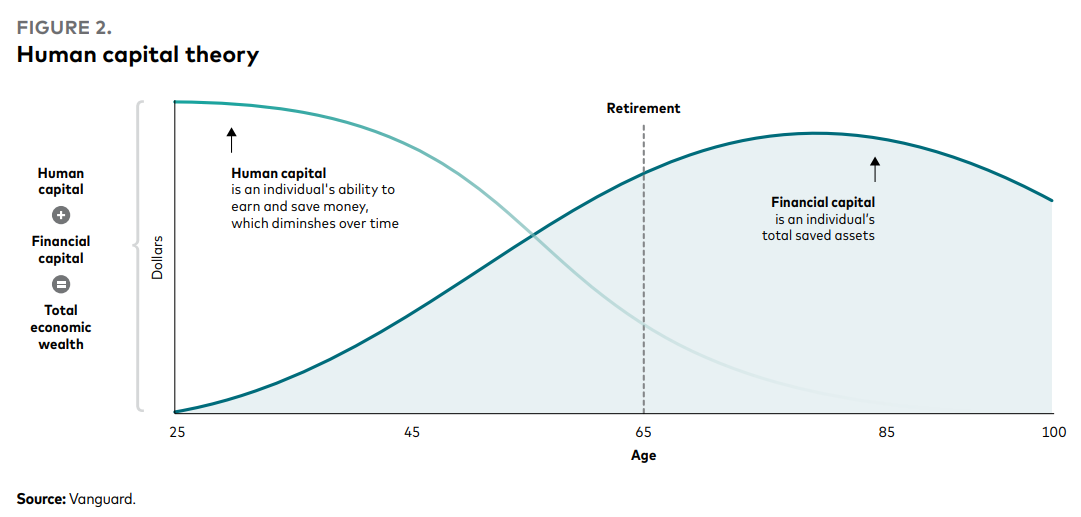
Of course, the devil is in the details. At what age should people begin to transition their financial capital from stocks to bonds? How should financial capital be invested? In which stocks? In which bonds?
Enter target date funds, or TDFs. These represent the financial industry’s solution for implementing the lifecycle investing paradigm laid out above. For example, in their TDF white paper, Vanguard shows the following glide path for how different age investors should allocate their financial capital. (Of course, a one-size-fits-all solution is not appropriate for everyone, and investors’ ideal allocations will differ based on their spending and liquidity needs, and their degree of risk aversion.)
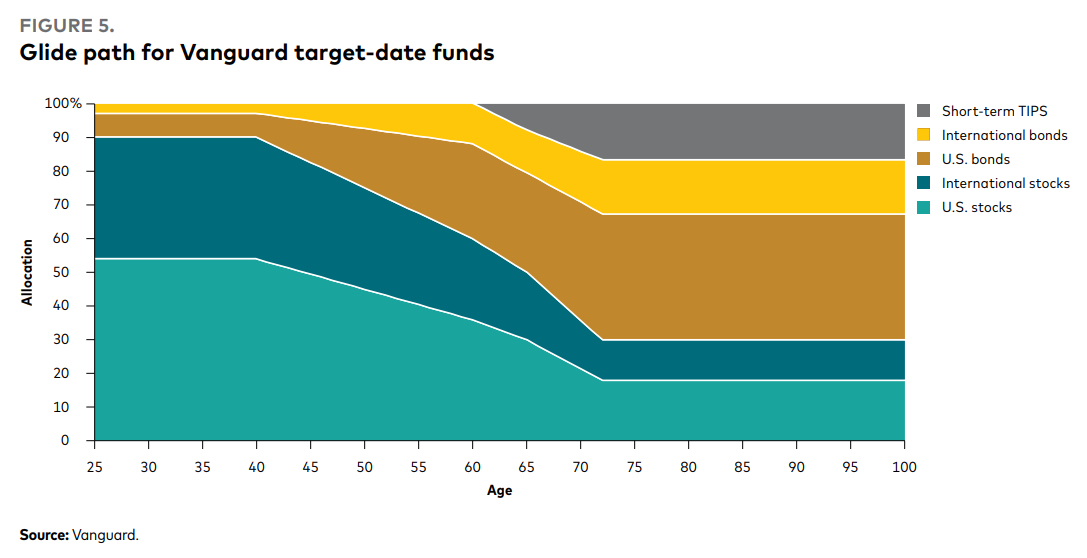
Interestingly, Fidelity’s glide path looks remarkably similar:
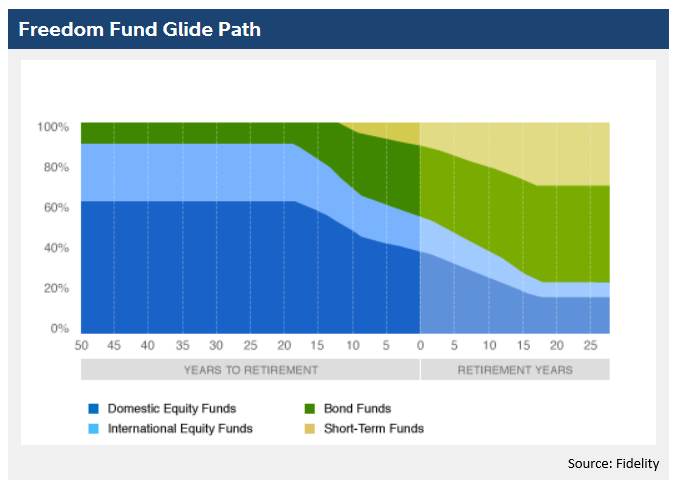
Looking across other investment managers reveals a similar structure.
To implement this investment strategy through target date funds, investors simply pick a fund corresponding to the anticipated year of their retirement. For example, if you are 35 years old and plan to retire when you are 65, you would pick the 2055 (2025 + 30 years to retirement) target date fund. The investment manager will do the rest by implementing their preferred stock-heavy asset allocation strategy today, along with a gradual transition to a more bond-heavy portfolio as you age.
Market penetration
The annual Investment Company Factbook provides extensive statistics on the market penetration of target date funds. According to the 2025 Fact Book, 401(k) participants who are currently in their twenties have close to two thirds of their total assets allocated to target date funds. For the younger generations, TDFs are their primary savings vehicle in 401(k)s.
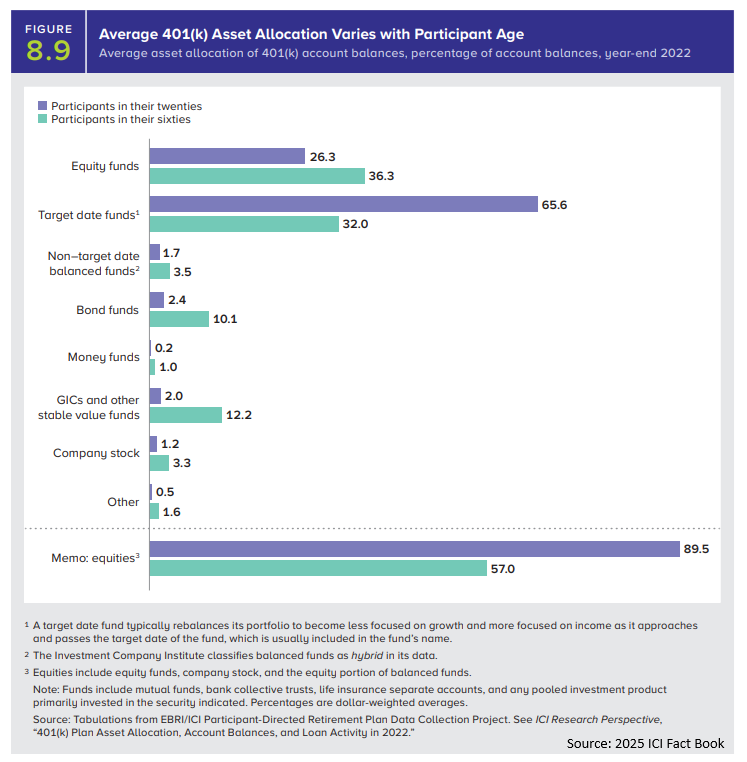
Looking across 401(k) plans more broadly (not just for investors in their twenties), the trend towards TDFs is clear. As of 2022, 88% of 401(k) participants are in plans that offer target date funds, with 68% of plan participants holding such funds, which represent 38% of all 401(k) assets under management. The trends in all three categories point towards increasing market adoption of TDFs.
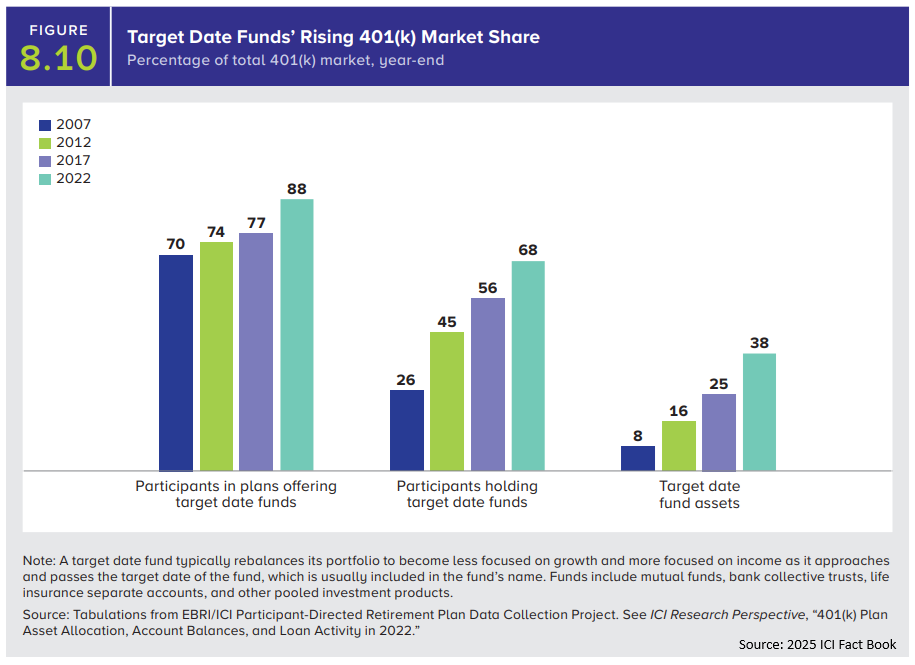
Explaining TDF returns
Given the importance of TDFs in the retirement ecosystem—and in investment plans more broadly—it is no surprise that virtually all major asset management firms offer TDFs to their clients. A partial list of such offerings is shown in Appendix A. Because large asset managers feature these products so prominently in their marketing materials (see, for example, JP Morgan’s and BlackRock’s TDF portals), we may reasonably infer that target date funds reflect the best organizational thinking for how to do asset allocation.
To dig into a fund’s strategy, one can look up its portfolio composition on the sponsor’s website. For example, the Fidelity Freedom 2065 Fund currently has a 94.5% equity allocation, spread out between many different US and international stock funds, has 10.7% in multiple US and international bond funds, and has short-term borrowing equal to 5.2% of its assets under management.
This fund-level analysis, while informative, is difficult to perform systematically across target date funds that come from multiple sponsors and with multiple retirement dates. Statistical approaches offer a more efficient solution. Towards this end, we collect return data on target date funds offered by major asset managers (see Appendix A) and find ones with a realized volatility over the prior year that is close to a 60/40, 85/15, and 95/5 stock/bond portfolio.
We combine all target date funds matching a given risk level, e.g., 60/40, into an equal-weighted portfolio, whose daily return equals the average of all of its constituent TDF daily returns. Having constructed this aggregate TDF return index for each risk bucket, we then select a set of building block portfolios that can explain TDF index returns. These building blocks, or factors (see Appendix A), consist of the S&P 500 and Nasdaq indexes, other US and international stock indexes, as well as several bond indexes that track US and international markets. All factors can be implement using highly liquid and low-cost exchange traded funds (ETFs).
We next find a portfolio of factors that does a good job explaining TDF index returns in each risk bucket over the last year. We require these TDF replicating portfolios to have no short positions (i.e., no negative weights) and to be fully invested (i.e., weights add up to 100%).
The next table shows the correlation of daily returns of the factor replicating portfolio for the 60/40 TDF index (labeled B_60) with the five target date funds that were classified into the 60/40 risk level over the last year. (The names of these funds, which have retirement dates of 2030, are shown in Appendix A.) The daily returns of B_60 have a correlation with the daily returns of the 60/40 TDFs of between 99% and 99.6% (see the top row in the table). Clearly, the factor replicating portfolio does a very good job capturing the variation in 60/40 TDF returns.
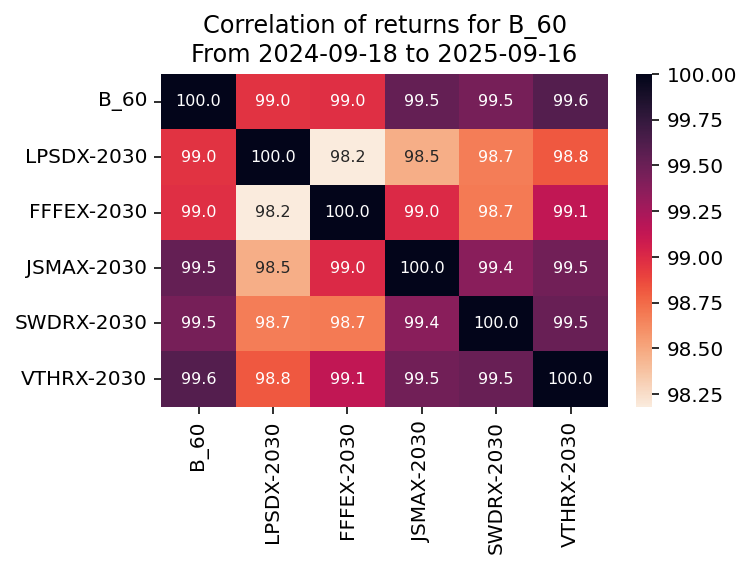
The correlations of daily B_85 returns (the 85/15 replicating portfolio) with the daily returns of TDFs classified into the 85/15 bucket over the prior year range from 98.4% to 99.8%. In fact, these correlations are all above 99.3%, except for the correlation with the returns of AAFJX (the American Funds 2070 Target Date Retirement Fund). For B_95, which replicates the returns of TDFs matched to the 95/5 risk level, the correlations range from 99.7% to 99.8%. (These results are shown in Appendix B.)
We conclude that liquid, low-cost, transparent ETFs (i.e., factors) can be used to construct replicating portfolios that have almost the exact return profiles of the target date funds offered by major investment managers.
How do TDFs invest?
The next table shows the replicating portfolios for each category of target date funds. The columns of the table correspond to the three different risk levels: 60/40, 85/15, and 95/5. The top rows (in grey) show the weights of the replicating portfolio for each risk level. For example, target date funds which operate at a 60/40 risk level can be replicated using a portfolio consisting of 29.4% SPX (S&P 500 index), 2% Nasdaq, 2.8% MID (midcaps), 3.6% RTY (Russell 2000, or smallcaps), 21% MXWOU (international stocks ex-US), 1.2% WBNDXUS (international government bonds ex-US), 7.6% US Agg (the Bloomberg US Aggregate Bond index), and 32.4% US Treas (an index of US Treasury bonds).
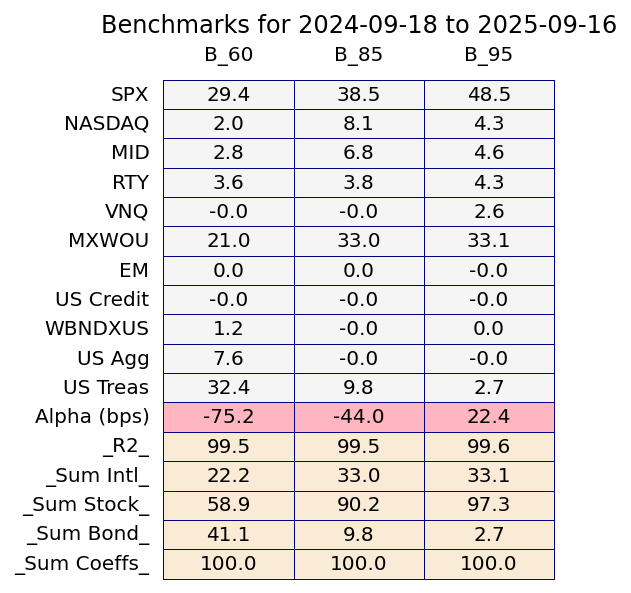
The row labeled Alpha (bps) shows the average performance of the target date funds relative to the replicating portfolio in basis points per year (one basis point is 0.01%). As an asset class, 60/40 TDFs underperformed the 60/40 replicating portfolio by 0.752% over the last year.
The _R2_ row shows that the 60/40 replicating portfolio captures 99.5% percent of the variation in daily returns of the target date funds index, thereby providing a very effective replication strategy. The _Sum Intl_ row shows that 22.2% of the 60/40 portfolio is allocated internationally, mostly to stocks but some to bonds. The _Sum Stock_ and _Sum Bond_ rows show that 58.9% of the portfolio is in stocks and 41.1% is in bonds. Finally, _Sum Coeffs_ verifies that portfolio weights add up to 100%.
The next two columns show the portfolio weights of the 85/15 and 95/5 replicating portfolios. The 85/15 portfolio has a heavier international allocation at 33%. It also has 90.2% of the portfolio in equity asset classes and 9.8% in bonds. On the equity side, in addition to the S&P 500 and non-US international stocks, the portfolio allocates to Nasdaq, mid- and smallcaps. The relative performance of the 85/15 target date funds is 0.440% lower than the performance of the replicating portfolio over the last year.
The 95/5 portfolio is also allocated one third internationally, but has a much smaller bond allocation of only 2.7%. There is also a small VNQ (real-estate investment trust ETF) allocation at 2.6%. The relative performance of the 95/5 target date funds exceeds that of the 95/5 replicating portfolio by 0.224% over the last year.
The _R2_ row shows that the 85/15 and 95/5 portfolios capture 99.5% and 99.6% of the variation in daily returns of the target date funds which the portfolios track. As before, these are very high tracking values.
Conclusion
The next chart shows the current value of a $1 investment in the target date funds used to construct the 60/40 index, as well as the value of $1 invested in the B_60 replicating portfolios, over the past year. Appendix B contains similar charts for the 85/15 and 95/5 portfolios. In all cases, the replicating portfolios track the day-to-day fluctuations of the target date funds very closely. At year end, some TDFs are above the replicating portfolios’ cumulative return and some are below, but this is likely just statistical noise around the mean, since return persistence in mutual funds is very hard to come by (see Carhart 1997).

Importantly, the replicating portfolios are transparent, consist of liquid and low-cost ETFs, are easy to implement, and yield valuable economic insights into the optimal asset allocation strategies of the top investment management firms in the US.
There are many more insights to be gleaned from this analysis. We will pursue these in future work.
Note that our work on this topic is ongoing, and the present methodology for constructing target date fund replicating portfolios may change in the future.
Appendix A
This section lists the target date funds used to construct the risk-specific (e.g., 60/40) benchmark portfolios, as well as the ETFs which are used as the replicating factors. The number next to each fund and ETF represents the assets under management in that specific share class of the fund, in millions of dollars.
Getting funds data from 2015-09-29...
AADTX-2025 [AADTX]: AMER FND 2025 TRGT RTRM-A 4,056
AAETX-2030 [AAETX]: AMER FND 2030 TRGT RTRM-A 5,100
AAHTX-2045 [AAHTX]: AMER FND 2045 TRGT RTRM-A 3,348
AAMTX-2055 [AAMTX]: AMER FND 2055 TRGT RTRM-A 2,127
AAFJX-2070 [AAFJX]: AMER FND 2070 TRGT RTRM-A 36
LPSDX-2030 [LPSDX]: BLCKRCK LIFEP DYN 2030-K 326
LINIX-2030 [LINIX]: BLCKRCK LFEPTH INDX 2030-INS 591
LIKIX-2040 [LIKIX]: BLCKRCK LFEPTH INDX 2040-INS 819
LIVIX-2055 [LIVIX]: BLCKRCK LFEPTH INDX 2055-INS 157
LIWPX-2065 [LIWPX]: BLCKRCK LFPTH INDX 2065-P 16
LIYAX-2070 [LIYAX]: BLCKRCK LFEPTH INDX 2070-A 0
FFTWX-2025 [FFTWX]: FIDELITY FREEDOM 2025 6,540
FFFEX-2030 [FFFEX]: FIDELITY FREEDOM 2030 10,366
FDEEX-2055 [FDEEX]: FIDELITY FREEDOM 2055 1,999
FFSFX-2065 [FFSFX]: FIDELITY FREEDOM 2065 274
FRBDX-2070 [FRBDX]: FIDELITY FREEDOM 2070 22
JSMAX-2030 [JSMAX]: JPM SMRT RETIREMNT 2030-A 686
JSAAX-2045 [JSAAX]: JPM SMRT RETIREMNT 2045-A 546
JFFAX-2055 [JFFAX]: JPM SMRT RETIREMNT 2055-A 311
JSMEX-2065 [JSMEX]: JPM SMRT RTRMNT 2065-A 12
TLQHX-2025 [TLQHX]: NUVEEN LIFECY INDX 2025-I 27
TLHHX-2030 [TLHHX]: NUVEEN LIFECY INDX 2030-I 51
TLMHX-2045 [TLMHX]: NUVEEN LIFECY INDX 2045-I 47
TTIHX-2055 [TTIHX]: NUVEEN LIFECY INDX 2055-I 32
TFIHX-2065 [TFIHX]: NUVEEN LIFECY INDX 2065-I 7
PBPNX-2030 [PBPNX]: PIMCO REALPATH BLND 2030-INS 599
PVQNX-2045 [PVQNX]: PIMCO REALPATH BLND 2045-INS 600
PRQZX-2055 [PRQZX]: PIMCO REALPATH BLND 2055-INS 476
PAJDX-2070 [PAJDX]: PIMCO REALPATH BLND 2070-INS 4
SWHRX-2025 [SWHRX]: SCHWAB TARGET 2025 FUND 425
SWDRX-2030 [SWDRX]: SCHWAB TARGET 2030 FUND 1,008
SWERX-2040 [SWERX]: SCHWAB TARGET 2040 FUND 1,280
SWYJX-2055 [SWYJX]: SCHWAB TARGET 2055 INDEX-INS 854
SWYOX-2065 [SWYOX]: SCHWAB TARGET 2065 INDEX 284
TRRKX-2045 [TRRKX]: T ROWE PR RTRMNT 2045-INV 6,317
TRBOX-2055 [TRBOX]: T ROWE PR RTRMNT BL 2055-INV 67
TRBPX-2060 [TRBPX]: T ROWE PR RTRMNT BL 2060-INV 20
TRPQX-2070 [TRPQX]: T ROWE PR RTRMNT BL 2070-INV 1
VTTVX-2025 [VTTVX]: VANGUARD TRGT RTRM 2025-INV 75,216
VTHRX-2030 [VTHRX]: VANGUARD TRGT RTRM 2030-INV 102,630
VTIVX-2045 [VTIVX]: VANGUARD TRGT RTRM 2045-INV 99,805
VLXVX-2065 [VLXVX]: VANGUARD TRGT RTRM 2065-INV 11,696
VSVNX-2070 [VSVNX]: VANGUARD TRGT RTRM 2070-INV 1,824
BIGPX [BIGPX]: BLACKROCK 60/40 TARGET-INST 480
FAMRX [FAMRX]: FIDELITY ASSET MANAGER 85% 2,531
Getting factors data from 2015-09-29...
SPX [VOO ]: VANGUARD S&P 500 ETF 794,193
NASDAQ [QQQ ]: INVESCO QQQ TRUST SERIES 1 373,364
MID [MDY ]: SPDR S&P MIDCAP 400 ETF TRST 24,386
RTY [IWM ]: ISHARES RUSSELL 2000 ETF 69,833
VNQ [VNQ ]: VANGUARD REAL ESTATE ETF 34,599
MXWOU [VXUS ]: VANGUARD TOTAL INTL STOCK 106,580
EM [VWO ]: VANGUARD FTSE EMERGING MARKE 101,295
US Credit [VCIT ]: VANGUARD INT-TERM CORPORATE 56,029
WBNDXUS [IGOV ]: ISHARES INTERNATIONAL TREASU 1,132
US Agg [AGG ]: ISHARES CORE U.S. AGGREGATE 132,244
US Treas [VGIT ]: VANGUARD INTERMEDIATE-TERM T 33,246
Appendix B
The next table show the correlations of daily returns of the target date funds being tracked by the 85/15 replicating portfolio with one another and with the B_85 replicating portfolio. All correlations are very high.
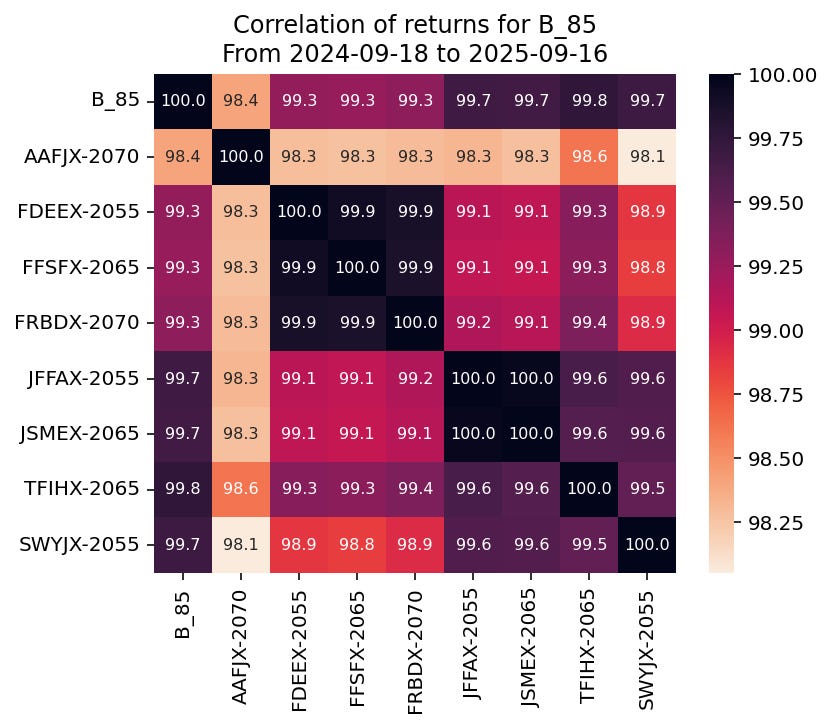
The next table shows the same analysis for the 95/5 replicating portfolio.
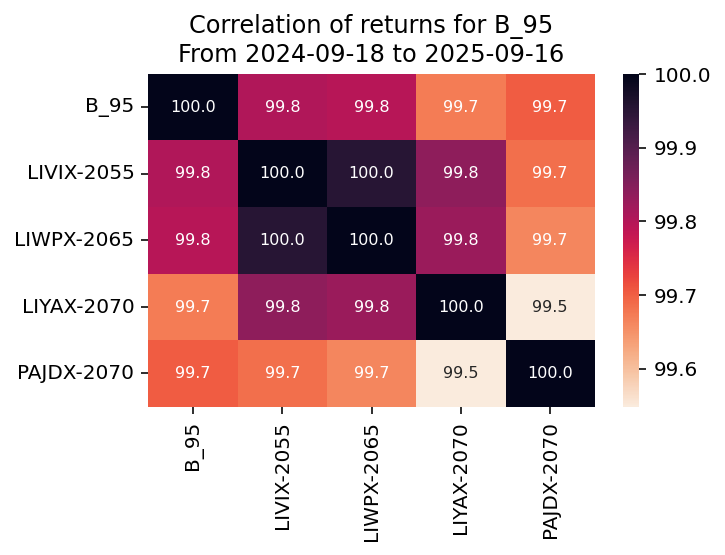
The next chart shows the current value of $1 invested one year ago in the target date funds being tracked by the 85/15 replicating portfolio, as well as the value of $1 invested in the 85/15 replicating portfolio (B_85).
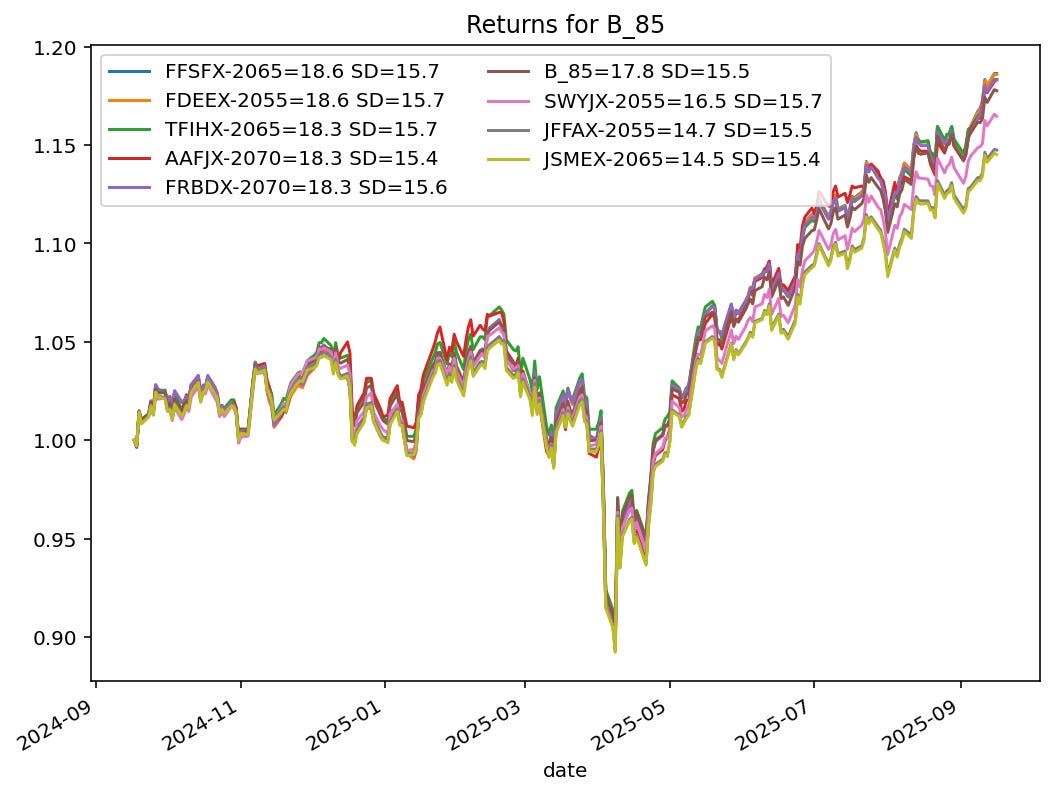
The next chart shows the same analysis for the 95/5 replicating portfolio and the target date funds it is constructed to track.
